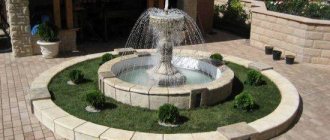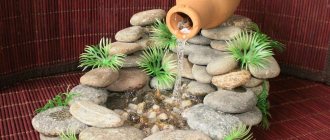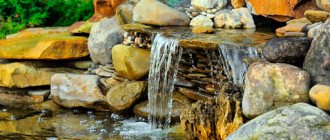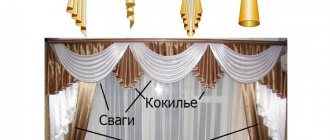Decorating a site is a favorite pastime of summer residents and homeowners. Beautiful flower beds, flower beds and even beds are a true decoration. However, nothing pleases the eye more than ponds and ponds surrounded by beautiful vegetation. And if a stream of water still comes out of it, then the corner turns into the best resting place. If you still manage to make not only a fountain with your own hands, but also beautiful lighting, put a swing or bench nearby, in the evenings all the inhabitants will gather on this patch.
This fountain is DIY and so is the lighting: a waterproof LED light with remote control for changing colors
Fountain device
To make a fountain at your dacha you don’t need to spend a lot of money. Of course, it all depends on the size of the reservoir and how you imagine it. Depending on the method of construction, fountains are of closed and open type. We are talking about the cyclical use of water. The closed type uses the same volume of water, driving it in a circle. Open - new all the time. Garden and country fountains are mainly made of a closed type: their design is simpler and more economical. Of course, water has to be added and changed periodically - it evaporates and becomes dirty, but still, the costs are not very high.
When installing an open type system, you will have to think through the water supply system, control of its level, drainage and disposal. You can, of course, use the fountain’s reservoir as a container for heating water before watering, and use the bowl to distribute it throughout the garden, but watering is not needed around the clock, and the fountain can operate in this mode.
A plastic container is visible, and the pump is located at the bottom, right in the place where the pipe sticks out of the water
In the simplest version, to make a small-sized fountain, you need some kind of sealed container and a submersible pump. Any container can be used - a special plastic one for a pond, a barrel, an old bathtub, a basin, a cut tire covered with film, etc. With pumps it’s a little more complicated.
Fountain pumps
Fountain pumps are sold specially, with built-in filters. To make it easier to make a fountain with your own hands, you can buy such models. It’s very easy to work with them: put them in a container, secure it so that it doesn’t move, fill it with water, carry out the starting manipulations (described in the instructions) and turn it on.
Fountain pumps come in different capacities and raise the jet to different heights. Often the kit comes with replaceable nozzles that change the nature of the jet. They are powered by a 220 V network; there are models powered by solar panels. They are made hermetically, so there will be no problems when connecting, no step-down transformers are needed. The only thing that won’t hurt is an automatic machine and an RCD on the line to which the pump will be connected. This is just in case, to increase security. The price of the smallest and lowest-power fountain pump is $25-30. Productive models cost several hundred or more.
You can use any submersible pump for the fountain. But you need to buy or make a filter for it (you can make a sand filter) and a step-down transformer. A security group from a machine gun and an RCD on the line will not be out of place here either. This circuit is worth tinkering with if you have an old pump that is not currently being used.
How to do it without a pump
Is it possible to make a fountain without a pump? It is possible, but it is open type. For example, bring a water supply pipe into the pond - central or supplying water from a well or borehole. The water coming out under pressure will produce a jet of some height. By installing a tip on the pipe, we can change its shape. But with such a construction, it is necessary to figure out where to divert the water. You can go back to the well or to the river, to the irrigation area, etc. Although with such an organization there is a pump, it pumps water into the house, and the fountain is only one of the flow points.
Scheme of organizing a fountain without a submersible pump
The second option is to place some kind of container at a height, supply water to it, and from there it is supplied through pipes to the fountain located below. To create a more or less decent jet height, the container must be raised 3 meters or higher. But the question remains: how to supply water there. Again using a pump, but no longer submersible. They are cheaper, but require a filter. You will also need a pit in which the equipment is installed. A system of pipes connects it to the bowl of the fountain.
Read how to make a waterfall here.
Necessary equipment
Designing fountains involves selecting the required equipment and future location. Much depends on the area of the site, the relief textures, and other features (garden fountain: cascading, jet, etc.).
Whatever type of object is planned, several basic details will be required for its construction:
- water tank;
- nozzle;
- fountain pump.
To construct the structure, you can purchase a ready-made container. It can be plastic, metal, stone. It is also possible to build a reservoir directly on the ground.
Next, you need to decide on the power of the pump and how the jet forms a pattern. The type of nozzles used and the height to which the water will rise will depend on the desired picture.
The pump can be surface or submersible. In the first case, it is located outside the boundaries of the reservoir, which makes access easier if repairs are required. In the second case, the equipment is installed under water.
It is also necessary to take into account the planned performance of the device:
- to create jets about 50 cm high, a pump that pumps up to 850 liters per hour will be sufficient;
- in order for the water to rise up to 100 cm, the productivity must be 2 thousand liters;
- a pump pumping 3-5 thousand liters per hour will create jets with a height of 1.5 to 2 m;
- the most powerful equipment (8 thousand liters per hour) raises water up to 3 m in height.
Other technical elements include a filtration system. It clears the water of small debris and prevents it from blooming. The fountain lamp is already a decorative object.
Fountain lighting
In this area, everything has become easier with the advent of LEDs. They are powered by 12V or 24V, which is much safer than regular mains. There are even lamps that run on solar-powered batteries.
Fountain lighting
Illumination can be done using waterproof LED strips or the same spotlights and lamps. To power them, you need an adapter that converts 220 V into 12 or 24 V, but they are usually sold in the same place where LEDs are sold, so there shouldn’t be any problems. Installation is simple: the spotlights have mounting brackets, the tape can be “shot” with a stapler, only the brackets need to be found larger than the size of the tape: there is no need to punch it, so as not to break the tightness.
There are LEDs that change color. Shades from 8 to several thousand
Selecting a location
The selection of the site on which the homemade fountain will be placed depends on the type of design adopted, landscape features and aesthetic feasibility. To place decorative cascade fountains for a summer residence, it is more profitable to use an artificial or natural break in the relief that logically coincides with the direction of water flow.
The pressure structure will decorate the open space in the garden, giving it the missing three-dimensionality. A decorative fountain with a cascade will add dynamics to a static landscape, emphasizing the beauty of nature with the play of light on the water surface.
Place the fountain in a quiet, shaded area, allowing you to appreciate the flow of streams and freshness on a hot day.
Schemes of fountains of different configurations and photos of their design
Surely you know that the main component of a fountain is its bowl. In essence, this is the same pond, but with additional equipment - a pump. A pond can be made in at least a dozen different ways, and some of them are described in a separate article, because we won’t describe how to make a bowl for a pool. We will pay maximum attention to the organization of fountains and their decor.
Small fountain
The device requires a container and a pump. Decoration is put on the tube that comes from the pump. These can be slabs of stone in which it is necessary to drill a hole, with a diameter slightly larger than the diameter of the pipe. These slabs are strung on top of each other like a children's pyramid.
Scheme of organizing a decorative fountain for a summer residence
To avoid water overflow, it is necessary to provide a drainage system - just below the maximum level, cut a pipe into the container, the second edge of which is led into the sewer system, drainage system or into the garden. You can do it another way: arrange a water collector around the bowl - make a concrete groove or dig in a plastic one. The collected water should also be taken somewhere. Usually in closed systems the problem is not overflow, but a lack of water - it evaporates, but you can play it safe.
DIY fountain: photo report 1
And now a photo report of how a mini-fountain was made with your own hands according to this scheme. It turned out interesting.
This decorative fountain took several hours to create.
To make this fountain you needed:
- square plastic flowerpot without holes;
- small fountain pump;
- a plastic pipe 0.7 m long, the diameter is such that it fits over the pump outlet;
- a bag of decorative pebbles;
- three bricks;
- red granite sawn into slabs.
The tool used is a drilling machine to drill holes in granite with a diameter slightly larger than the diameter of the pipe.
Installing a fountain container
We install a bowl in the prepared hole and place bricks in it, closer to the edges. They are needed for the stability of the structure and to reduce the amount of pebbles. They also serve as support for the stone structure. Between the installed bricks we place a pump with a tube on, pour in water and check how it works.
Holes were pre-drilled in the slabs in the workshop. They should be located approximately in the center so that the weight of the stones does not overturn the structure.
Folding the fountain
The first slab rests on lying bricks, the rest are strung so that the center of gravity does not shift. Having laid the first one, we fill the remaining space with pebbles. After the last piece is laid, a mark is made on the pipe. The very last stone is removed, the pipe is cut down just below the mark, then the last fragment is returned to its place. When the water is turned on, it seems to come straight out of the stone. Very unusual and uncomplicated.
Photo report 2
The next version of a small fountain is made according to the same principle, only a flexible hose is used instead of a pipe, and driftwood is used instead of a stone. The effect was simply wonderful.
Making a small fountain with your own hands
Everything is so clear that there is no need for comments. It differs from the previous design only in the presence of a mesh. This is to increase the volume of water: the tray is small in size.
Fountain decoration
Until you see it, it’s hard to imagine how easy it is to make amazingly beautiful things. As for pipes, it is better to use polyethylene pipes - they bend well and are not afraid of ultraviolet radiation.
How to make a fountain from a tire, see the video report.
Room or tabletop
Mini-fountains are made according to the same principle, only they use very low-power pumps. Suitable even for aquariums, but without aeration. They even work almost silently. We will make a fountain in the Japanese style. In addition to the pump, you will need a small ceramic container for this. In our case, oval made of baked clay. A piece of bamboo - about 70 cm long (bought at a flower shop, sold as a support for climbing plants), a bunch of living growing bamboo and a number of small pebbles. From all this comes such beauty.
Do-it-yourself home mini fountain
First of all, cut a piece of bamboo into pieces of different lengths. It is hollow inside - these are natural pipes, which also do not rot for a long time. One of the sides should have an oblique cut, the other should have an even cut. You cut it so that the longest piece near the evenly cut end has a “joint”. The lower incision goes approximately 5 mm below this thickening. There is simply a partition inside, with its help it will be easy to attach this segment to the pump outlet. It is difficult to cut, but I managed to saw through the thin trunk with a metal blade.
We cut bamboo into three pieces of different lengths
We put a small pump in the vessel, put the longest piece of bamboo on it - its length is about 35 cm. On the other side we put a bunch of living bamboo, filling the space between them with pebbles.
Filling the mini fountain
We tie the two remaining pieces of dry bamboo to our “pipe”. You can use hemp rope. That's all, we made a mini fountain with our own hands. All that remains is to add water and turn on the pump.
Other models can be made using the same principle. Now you understand how and it will be easy to change the design. A few photos for inspiration.
Another indoor bamboo fountain in Japanese style
Outdoor fountain made of granite bowl and bamboo
Another type, more traditional and familiar to us, uses almost the same idea and the same tools. The difference is in the design. You can take a large ceramic or even plastic pot. It is only important that it has no holes for drainage. Then it’s a matter of technique: divide it with a plastic partition into two or three zones, pour more soil into one and plant one of the moisture-loving plants.
How to make a mini fountain
The second part will be the reservoir. Only when organizing circulation is multi-stage filtration necessary: the water becomes very contaminated. Therefore, glasses made of filter materials with different meshes are inserted one after another - first - a wire or plastic mesh, then - fabric with different meshes, and inside this structure - a small pump.
Tabletop mini fountain
You can make with your own hands not only the composition of such a tabletop fountain, but also a pump. How? Watch the video.
Pebble fountain
The fountains with pebbles have a very interesting design. Their bowl is disguised, so it looks like a dry fountain, without a bowl. In fact, there is a bowl, but it is decorated with pebbles, which are laid on a mesh covering the tank.
Dry pebble fountain - device diagram
A container is installed in the dug pit. Its volume and size should be quite decent: to collect all the splashes, or at least most of them. Place a pump in the container and cover the top with a metal or plastic mesh with a fine mesh. It serves to protect against large contaminants getting into the water, and a thick wire mesh can be laid on top of this fine mesh. This is if you use pebbles. If you are laying stone slabs, you can use boards or bars.
How to make a “dry” fountain with your own hands
With pebbles, it’s probably better to do the opposite: first lay a mesh with a large cell as a base, and on top of it with a small one. This way you won’t have to worry about choosing large pebbles, and debris won’t get into the water.
Rockery with a source - this is what this fountain might look like. For decorating a garden in a modern style, this option is more suitable
If you use your imagination, you can come up with very interesting compositions based on this. For example, one of the options with a garden watering can. If your garden is decorated in a classic style, a watering can fountain is unlikely to fit well, but it will fit very well into a country style.
Watering can garden fountain
As you can see, water is collected in the same vessel, hidden under pebbles, and from there it is pumped into a watering can with a small pump.
Near the wall
This is a classic option - a small or large stream of water runs from the wall, flowing into the bowl. As you may have guessed, there is a pump in the bowl that supplies water through a pipe to the water outlet point. It's simple if you know how. It's just a matter of implementation and decoration.
Scheme of organizing a waterfall near the wall
To prevent the pump from floating, it is screwed to some kind of heavy plate. At least for the sidewalk, as long as the size fits. The case usually has corresponding holes for mounting, but when choosing, you should pay attention to this.
Classic design of wall fountain
If you plan to do something similar near the wall of a house or fence, take care of its waterproofing. Even if the water does not flow down the wall, splashes will fall on it and the humidity will be increased. At a minimum, it is necessary to coat it several times with a hydrophobic compound. Try to find one that doesn't change the color of the surface too much.
Another option for a fountain against the wall
The design style may be different. A flat surface is made at the top bowl, from which water flows off like a wall. The effect is very interesting. It is important that the surface from which the water falls is mirror-smooth and absolutely horizontal.
Beautiful fountain for a garden in a minimalist or modern style
Fountain-cascade
The iridescent jets look very interesting. Fountains of this type are called cascades or cascading. With this organization, water is poured from one bowl to another. In the case of a country or garden fountain, you can come up with interesting shapes. For example, a fountain made from buckets, watering cans, teapots and even old garden carts.
Fountain cascade of garden carts
The principle of organizing such a cascade is simple: several vessels or bowls mounted above each other so that a stream of water flows from one to the other. At the bottom is the largest tank, where the pump is located. He delivers water through a hose to the highest of the vessels.
Another decorative garden fountain
Stylish exoticism in the interior of the bedroom
A small tabletop fountain can be made from a flower pot with a diameter of approximately 25 cm.
To work you will need:
- durable container;
- pump;
- translucent balls or pebbles;
- aquarium plants;
- paints for painting on ceramics or glass.
A flower pot is used for the base of the fountain. To give the structure a stylish look, the container is painted with special waterproof paints. To circulate the liquid, install a pump, make a hole and bring the tube up.
The bottom of the fountain is decorated with decorative balls, shells or pebbles. After filling the system with water, aquarium plants are placed inside. They give the design an exotic look and uniqueness. A simple design creation scheme opens up wide opportunities for beginning craftsmen.
How to make a fountain bowl
If you need a classic shape - a round, square or oval bowl from which a stream of water flows, the easiest way to find a suitable plastic tank. They come in different shapes and volumes - from tens of liters to several tons. In color they are mainly black and blue. Although it seems that for our purposes it is better to take a blue color, keep in mind that against such a background the pollution is more visible. To prevent your fountain from looking like a swamp, you will have to clean this bowl often. From this point of view, it is more practical to take black - the water looks the same, but you need to wash it less often.
Garden fountain made of plastic bowl
The selected tank can either be buried flush with the ground level, or leave a side. Most often, the sides are decorated with stone or pebbles. Depending on this, choose the depth of the pit. It is dug out and is slightly larger than a bowl.
You can read about how and with what you can decorate the site here.
When the required depth is reached, all the stones, roots, snags are removed, the bottom is leveled, compacted, sand is added in a layer of about 10 cm. It is well leveled and spilled so that it becomes compacted. Place the bowl on the prepared base and fill it with water. Sand or soil is poured into the gap between the walls of the bowl and the pit. Sand - if the soil is clayey, and soil - if it drains normally. Having filled in a small layer, it is compacted - carefully, using a pole or deck to get into the gap to be filled. But no matter how well you compact, be prepared for the fact that in a couple of weeks you will have to add more: the soil will shrink by several centimeters.
The bowl protrudes above the ground level
You can do without a plastic bowl. There are two other options: make the tank from monolithic concrete. In this case, you can make a fountain with sides. The process is long and expensive, and you also need to worry about waterproofing.
The cheapest option is to dig a pit and line it with film. In principle, any high-density polyethylene will do, but it will last a year, maybe two. Then it begins to let water through. Special films for swimming pools are more reliable in this regard, but they cost a lot of money, but can be used for years. The technology for making such a fountain bowl is captured in the photo.
Pit marking and excavation work
The first stage is digging a pit and leveling the walls. After the required shape and dimensions are achieved, the horizontal areas are leveled and covered with a layer of sand. It will protect the film from possible damage.
We lay the film in the finished pit. It should lie inside without tension, freely. Its edges are covered with soil and pressed down with boulders. To prevent plant roots from growing through the film, it is not advisable to lay geotextiles underneath. This is a non-woven fabric that is very tear resistant. It is used when laying roads to prevent the soil from being crushed and trees from sprouting. So she can protect the fountain without difficulty.
Laying film in the pit
Boulders are laid out on the laid film. If the pit is stepped, boulders should lie on each step. When the design of the bowl is almost complete, a pump is installed. The bowl is filled with water and the bowl is tested for leaks and pump performance.
The film laid in the pit is decorated with boulders. After installing the pump
Actually, that’s it, if the electricity is supplied, you can start the fountain.
Care and maintenance rules
We have already understood how the fountain works, based on the required equipment, but we should not forget that the fountain needs to be periodically looked after and serviced. To avoid equipment breakdowns and other problems, you need to follow a few simple rules:
- regardless of the type of tank (concrete, metal, plastic), you need to regularly check it for integrity;
- change the water in the bowl as it gets dirty (if there is a filtration system, this can be done less often);
- chemical cleaning agents are effective, but can harm plants or fish (if present);
- maintaining an optimal water level (in reservoirs with a closed system it quickly evaporates);
- before the onset of cold weather, the water is drained, and the structure is dismantled and sent to a place protected from moisture and frost;
- the tank itself is covered with a protective film (if cracks are detected, additional treatment will be required).
Photo design ideas
Why does water flow
“All rivers flow into the sea, but it does not overflow.” This is what it says in the most ancient book of humanity. We see confirmation of these words every day when snow or rain falls from the sky to the ground. The Great Designer launched the water cycle in nature. Imitating him, experienced craftsmen created with their own hands a decorative indoor fountain that pleases the heart all year round. How does this system work?
Necessary materials
In order to understand what and how much material will be needed, first determine the type of waterfall and its size. But there are three main components, without which not a single waterfall on the site can do.
The design of a site is rarely complete without constructing a reservoir.
- Storage capacity.
- Pump.
- electrical power source. Additional elements are stones for creating a cascade, hoses, sand, crushed stone, waterproofing, concrete mixture.
Additional Information! Construction film is sometimes used as a storage vessel!
Enchanting effect
Fountains are decorative in appearance, especially during the day. With the onset of dusk, their undeniable beauty hides in the darkness. But this can be corrected with the help of underwater and surface lamps.
Under artificial lighting, streams of water become magical, bewitching threads. With the help of LED waterproof lamps, the fountain turns into a fairy-tale object.
The stream of water in the fountains near the walls flows freely, gravity helps in this. The appearance of springs originating at the bottom of a reservoir can be created using nozzles that should be immersed in water.
Types of indoor waterfalls
Waterfalls are distinguished by their shape, how high the water rises and how it flows. The following varieties are distinguished.
- Exotic - it uses artificial stone of various textures and shapes, living plants, shells, jugs, mirrors. As a rule, this type of waterfall always has a fence.
Important! The design of such a waterfall is always large, so this factor is taken into account during installation!
- Classical. This design represents a continuous stream of water flowing over the glass. Another name is “waterfall on glass.” They don’t use any decorations, it’s a simple waterfall look.”
- Combined. The principle of pouring water is similar to the previous type, but the waterfall itself has decor in the form of stones, plants and other elements.
It is important to have a pump and a place to turn it on.
You can do everything else yourself. Also, according to the type of installation, decorative waterfalls are divided into continuous and collapsible, those that move, and those that sing. The type of design depends on the location in which it will be located.
Kinds:
- floor;
- wall;
- desktop;
- columns;
- partitions.
A DIY indoor waterfall is a worthy alternative to expensive factory products.
Communications
Necessary communications to create a waterfall:
- pipes that will be in the water treatment system;
- a device that collects the top layer of water and supplies it to the filter;
- wires for lighting.
The entire filtration system is installed at the bottom of the container.
In the future, they can be hidden by decorating with stones. All these communications are positioned in such a way that the shield is close to the waterfall itself.
Important! At this stage of work, be sure to check the operation of the pump!
DIY indoor waterfall
In order to install a home waterfall with your own hands, it is not necessary to resort to the help of professionals. Many people do it on their own, it’s not difficult, the main thing is to follow a certain algorithm of actions and approach it with full responsibility.
It will turn out completely unique and will be relatively cheap.
The very first stage is to determine the type of waterfall, the place where it will be located, and its size. These indicators determine what materials will be needed during the work. Once the scope of work is determined, the appropriate materials and tools are purchased.
Further actions depend on what kind of waterfall will be installed.
We install waterproofing of thresholds
Thresholds require high-quality waterproofing. The film used after the construction of the pool is used as film. Any waterproofing fabric and agrofibre are also suitable.
Waterproofing is done on both sides, leaving a slight overlap on the curbs.
After the waterproofing work is completed, the installation of decorative stones begins. They are attached to the waterproofing; a moisture-resistant sealant is chosen as the glue.
Near the rest area
The fountain is best placed next to the seating area. This could be a gazebo or patio. It is advisable that this place be viewed from the windows of the living room, so that you can once again admire such beauty up close.
The pond in which the fountain splashes will look more natural in the lowest part of the site.
It should not be placed entirely in the sun, where water may bloom, or in deep shade, where it is less decorative. The best place for a fountain will be partial shade.
You should not build this object under deciduous trees; the leaves will pollute the fountain bowl, and the roots can damage it.
The fountain should be positioned so that it reflects other decorative garden objects or beautiful plants.
Merry Pond
The presence of a pond on the site already charms and pleases. But the fountain for the pond is its special decoration. This motor revives the motionless surface of the water, makes it move, play, reflecting glare from the sun's rays.
If there is already a pond on the site, then installing a fountain will not be difficult. The fountain pump runs on electricity, so power points should be provided.
If plants live in the pond, then the water stream should be located 50 cm from them. The shoreline of the pond must correspond to the overall landscape design of the entire site.
Basis for the cascade
The base must meet several requirements:
- be moisture resistant;
- wear-resistant;
- be resistant to temperature changes.
Typically, concrete blocks are chosen as the base, which are then decorated.
These blocks are used to form a cascade of the required height; they can be left unattached to each other.
The first stage is positioned in such a way that it partially covers the place where the communications are located.
Subsequent steps are always smaller than the previous ones.
The lowest step is decorated with a border, which is subsequently decorated.
Where water outflow is planned, the walls are made smaller in height.











